Guys,
Just wondering if there's any real reason why domestic speakers seem to be designed with loads of baffle step and then plonked far from the walls?
I mean, in studios we use flush mount, and in most domestic environments it would make much more sense to mount the speakers on the wall and not have to deal with baffle step...
So are there any other acoustic reasons for this?
I ask because my silly flat has lots of foundation walls with plasterboard partitions, so it makes complete sense to make a "corner wall speaker" that sits in the recess, it's about 15cm deep, so I could have something like 4 4" speakers in there, admittedly the bass would roll off from about 100Hz, but given the environment (i.e. neighbours in a block of flats) that's probably no bad thing... so why aren't comercial speakers more like this?? am I missing something?
Just wondering if there's any real reason why domestic speakers seem to be designed with loads of baffle step and then plonked far from the walls?
I mean, in studios we use flush mount, and in most domestic environments it would make much more sense to mount the speakers on the wall and not have to deal with baffle step...
So are there any other acoustic reasons for this?
I ask because my silly flat has lots of foundation walls with plasterboard partitions, so it makes complete sense to make a "corner wall speaker" that sits in the recess, it's about 15cm deep, so I could have something like 4 4" speakers in there, admittedly the bass would roll off from about 100Hz, but given the environment (i.e. neighbours in a block of flats) that's probably no bad thing... so why aren't comercial speakers more like this?? am I missing something?
One indirect benefit of having speakers out from the walls is that it tends to put them closer to your listening position, thereby more in the near field (more direct/speaker sound, less reflected/room sound), which I personally enjoy a lot.
-- Jim
-- Jim
ooh, that's a very good point that I hadn't even thought of. Obviously my rooms are designed to try and break up reflections and standing waves as much as possible without it being obvious, but I guess that's a lot less likely with a "typical" domestic user.
Though the advantages of wall mount at a base level seem to still out-weigh the disadvantages
Though the advantages of wall mount at a base level seem to still out-weigh the disadvantages
For the best sound stage speakers are always placed at a distance from the walls. And this placement can often be quite critical and may require experimentation to find just the right location. The reason is because of nodes which occur between the speakers and the walls. And they just sound better out there. But in general the placement starts with forming an equilateral triangle with the listing position at the apex. As a thirty year member of a local audio society I have been exposed to a great many systems. Most of them pretty high end. None of them had speakers near a wall. Perhaps a good place to start is with this article. Below are a few pictures from recent society meetings.
Attachments
-
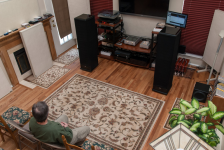 alan.png727.8 KB · Views: 458
alan.png727.8 KB · Views: 458 -
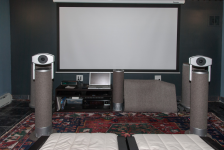 acda40bcfafb41e88d93f69336cda157.png527.1 KB · Views: 457
acda40bcfafb41e88d93f69336cda157.png527.1 KB · Views: 457 -
 56528ecb989f91c8a1538142f4709105.png593.1 KB · Views: 445
56528ecb989f91c8a1538142f4709105.png593.1 KB · Views: 445 -
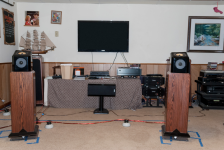 7fd6b90c13c6b3736288c8c2278e9128.png584.6 KB · Views: 443
7fd6b90c13c6b3736288c8c2278e9128.png584.6 KB · Views: 443 -
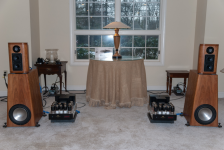 161af46510dbd7e85483d3cd7969274a.png585.3 KB · Views: 443
161af46510dbd7e85483d3cd7969274a.png585.3 KB · Views: 443 -
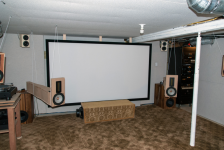 7600938cd2e04f1d8f9cd4418497461d.png588.5 KB · Views: 250
7600938cd2e04f1d8f9cd4418497461d.png588.5 KB · Views: 250 -
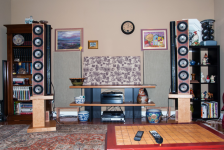 ccf1374dbff836ab8193e7a4b24722e7.png664.6 KB · Views: 248
ccf1374dbff836ab8193e7a4b24722e7.png664.6 KB · Views: 248
I like having speakers on the wall and never had issues with imaging be it depth or left-right.
However I do always close my eyes when I seriously listen.
If I open them my eyes disagree with my ears and all depth perception disappears accordingly. Having the speakers either side of a window helps but can create non-psychoacoustic problems.
If I had the cash and the space I'd soffit-mount my speakers as my ideal speakers would be invisible and I dislike speakers which draw visual attention to themselves.
However I do always close my eyes when I seriously listen.
If I open them my eyes disagree with my ears and all depth perception disappears accordingly. Having the speakers either side of a window helps but can create non-psychoacoustic problems.
If I had the cash and the space I'd soffit-mount my speakers as my ideal speakers would be invisible and I dislike speakers which draw visual attention to themselves.
It really depends what the speakers were designed for and how much baffle step correction was put in the crossover. Studio far field monitors are designed for that as are the studios they go into!
A lot of domestic speakers have poor directivity control and no bass management so you have to position them as they were voiced to get good performance. Oh and ports at the back which causes issues
NHT speakers are worth looking at for an alternative approach. They were designed to work with the back of the cabinet against the wall. Also the works of the late Peter Snell which were designed for corner location.
A lot of domestic speakers have poor directivity control and no bass management so you have to position them as they were voiced to get good performance. Oh and ports at the back which causes issues
NHT speakers are worth looking at for an alternative approach. They were designed to work with the back of the cabinet against the wall. Also the works of the late Peter Snell which were designed for corner location.
There are speakers designed for on wall and very near wall as billshurv has pointed out. The BBC "Gundry Dip" was part of the intentional design of the old LS35a speakers and works wonders for granting apparent depth of imaging with near wall placement is necessary. Current designs from Wisdom Audio, LRE Audio, and others, have done a nice job with near wall placement as well. And "on the wall" can work too, it just has to properly handle wide dispersion issues, octave to octave balance, etc. In my opinion this approach allied with multi subwoofers is the most practical approach to great sound in most modest size home environments. But then again I love the impracticality of some great speaker systems 🙂
I know on/in-wall stuff has improved over the years, although I haven't heard a really good setup (I need to get out more). I might be a tougher sell since I've grown accustomed to the near-field sound. But yes, the home situation is a strong factor with this particular choice. I'm an old bachelor, so I can put my speakers wherever the hell I please. Plus, this newfangled DSP stuff has allowed me to tweak the baffle step comp to perfection. 🙂
-- Jim
-- Jim
There are speakers designed for on wall and very near wall as billshurv has pointed out. The BBC "Gundry Dip" was part of the intentional design of the old LS35a speakers
Without wishing to pull this one up, there was no intentional 'dip' in the LS3/5a, they just couldn't build them to spec. Read the original BBC research paper.
From Harbeth, who should know because Harwood was there at the time
There is much myth, folklore and misunderstanding about this subject.
The 'BBC dip' is (was) a shallow shelf-down in the acoustic output of some BBC-designed speaker system of the 1960s-1980s in the 1kHz to 4kHz region. The LS3/5a does not have this effect, neither in the 15 ohm nor 11 ohm, both of which are in fact slightly lifted in that region.
However the myth has entered the Internet, from which it can never be removed!
Perhaps I was mistaken about the "gundry dip" but my source was from a talk by Bob Carver and I would say still worth investigating if one has the requisite equipment and skills to do so.
It has entered folklore.
Now a dip around 2-3kHz DOES give a sense of depth as 8kHz gives a sense of height. http://www.tubecad.com/articles_2002/Missing_Sonic_Controls/Sonic_Control.pdf is worth a read. Mix engineers are aware of these tricks and use them when painting the soundstage. Certainly nothing wrong with adjusting to taste in ones own system.
Now a dip around 2-3kHz DOES give a sense of depth as 8kHz gives a sense of height. http://www.tubecad.com/articles_2002/Missing_Sonic_Controls/Sonic_Control.pdf is worth a read. Mix engineers are aware of these tricks and use them when painting the soundstage. Certainly nothing wrong with adjusting to taste in ones own system.
The reason is that loudspeakers can sound better away from walls - less than optimum sound is obtained from an in-wall mounting. By that I don't mean that the loudspeaker itself is bad, rather it's the nature of our psycho-acoustic hearing process that makes a loudspeaker that is moved out into the room by 3 feet or more sound better.
I'd agree that for the most part the IDEAL set up is out away from the back wall and early reflections etc. But at the same time for me it is an interesting exercise to see what can done with near wall and on wall set ups for environments that simply can't allow that spacious speaker placement. Hear I'm thinking of dorm room, small office. small homes, etc. Although I've never heard them in person I noted that the super expensive Steinway Lyngdorf speakers have on wall set ups with plenty of dsp applied. I suspect that there is plenty of room for creative diy geniuses to gain more satisfying sound in smaller quarters without resorting to headphones. Just my 2 cents worth.
Another problem with wall mounting, it excites the wall and muddies up the bass. The stiffer the wall the better. Better if mounted to a stud and speaker size set to small.
NHT speakers are worth looking at for an alternative approach. They were designed to work with the back of the cabinet against the wall. Also the works of the late Peter Snell which were designed for corner location.
This is true for NHT center channel speakers and on wall speakers. All others are designed for use away from the back wall.
This is true for NHT center channel speakers and on wall speakers. All others are designed for use away from the back wall.
NHT 3.3 loudspeaker | Stereophile.com
Would tend to disagree with you.
EDIT: I was talking about the classic NHT speakers from the 90s, the modern company may have morphed into another me too!
NHT 3.3 loudspeaker | Stereophile.com
Would tend to disagree with you.
EDIT: I was talking about the classic NHT speakers from the 90s, the modern company may have morphed into another me too!
The 3.3 was a unique speaker. It was almost 3' deep! so in fact the main drivers were well away from the back wall. I had some in my house for a time. Fabulous speaker. I had them positioned 1' from the back wall. Any closer and there was too much bass. Of course peoples tastes are different. I have worked at NHT for 10 yrs. Most people who listen to 2 channel stereo use the speakers away form the back wall so that is the way we design them. Our moto is "High end but not high priced".
The reason is that loudspeakers can sound better away from walls - less than optimum sound is obtained from an in-wall mounting. By that I don't mean that the loudspeaker itself is bad, rather it's the nature of our psycho-acoustic hearing process that makes a loudspeaker that is moved out into the room by 3 feet or more sound better.
Moving a speaker away from the wall behind it, will cause a dip in the response. The further away, the lower the frequency and the deeper the dip. Low frequences benefit from close to wall placement!Frequences above circa 300 Hz does not. But if you add damping to the wall or a bit in front of it, it will work very well! The smearing of the soundstage will also be removed, just leave some undamped area in the center between the speakers.
- Home
- Member Areas
- The Lounge
- speaker placement - is it really important? and why away from walls?